西方建筑的五种柱式报告
- 格式:doc
- 大小:561.00 KB
- 文档页数:2
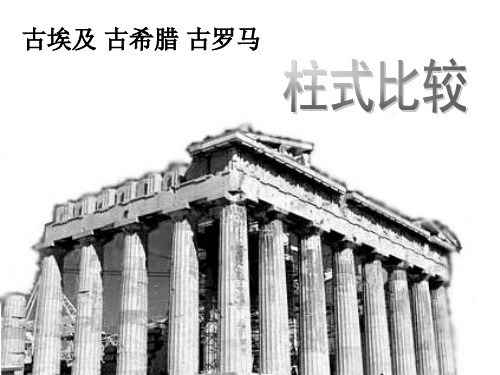
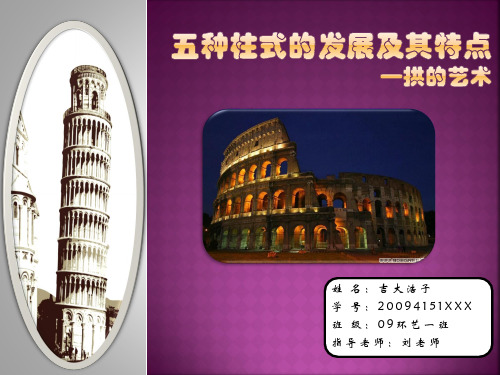
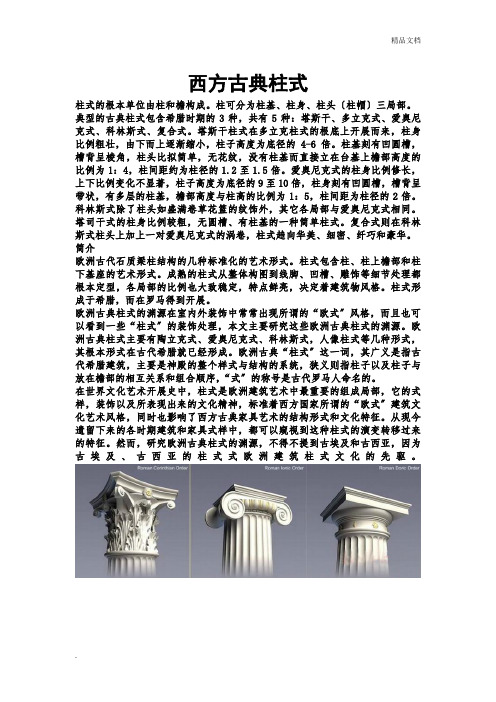
西方古典柱式柱式的根本单位由柱和檐构成。
柱可分为柱基、柱身、柱头〔柱帽〕三局部。
典型的古典柱式包含希腊时期的3种,共有5种:塔斯干、多立克式、爱奥尼克式、科林斯式、复合式。
塔斯干柱式在多立克柱式的根底上开展而来,柱身比例粗壮,由下而上逐渐缩小,柱子高度为底径的4-6倍。
柱基刻有凹圆槽,槽背呈棱角,柱头比拟简单,无花纹,没有柱基而直接立在台基上檐部高度的比例为1:4,柱间距约为柱径的1.2至1.5倍。
爱奥尼克式的柱身比例修长,上下比例变化不显著,柱子高度为底径的9至10倍,柱身刻有凹圆槽,槽背呈带状,有多层的柱基,檐部高度与柱高的比例为1:5,柱间距为柱径的2倍。
科林斯式除了柱头如盛满卷草花篮的纹饰外,其它各局部与爱奥尼克式相同。
塔司干式的柱身比例较粗,无圆槽、有柱基的一种简单柱式。
复合式则在科林斯式柱头上加上一对爱奥尼克式的涡卷,柱式趋向华美、细密、纤巧和豪华。
简介欧洲古代石质梁柱结构的几种标准化的艺术形式。
柱式包含柱、柱上檐部和柱下基座的艺术形式。
成熟的柱式从整体构图到线脚、凹槽、雕饰等细节处理都根本定型,各局部的比例也大致稳定,特点鲜亮,决定着建筑物风格。
柱式形成于希腊,而在罗马得到开展。
欧洲古典柱式的渊源在室内外装饰中常常出现所谓的“欧式〞风格,而且也可以看到一些“柱式〞的装饰处理,本文主要研究这些欧洲古典柱式的渊源。
欧洲古典柱式主要有陶立克式、爱奥尼克式、科林斯式,人像柱式等几种形式,其根本形式在古代希腊就已经形成。
欧洲古典“柱式〞这一词,其广义是指古代希腊建筑,主要是神殿的整个样式与结构的系统,狭义则指柱子以及柱子与放在檐部的相互关系和组合顺序,“式〞的称号是古代罗马人命名的。
在世界文化艺术开展史中,柱式是欧洲建筑艺术中最重要的组成局部,它的式样,装饰以及所表现出来的文化精神,标准着西方国家所谓的“欧式〞建筑文化艺术风格,同时也影响了西方古典家具艺术的结构形式和文化特征。
从现今遗留下来的各时期建筑和家具式样中,都可以窥视到这种柱式的演变转移过来的特征。

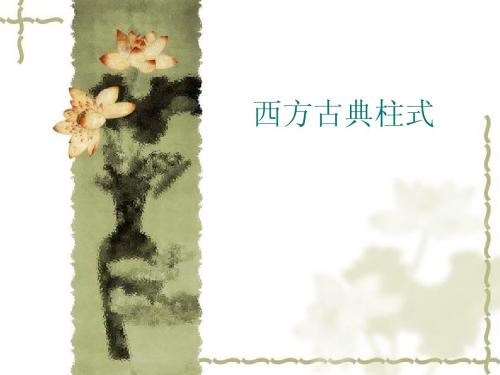
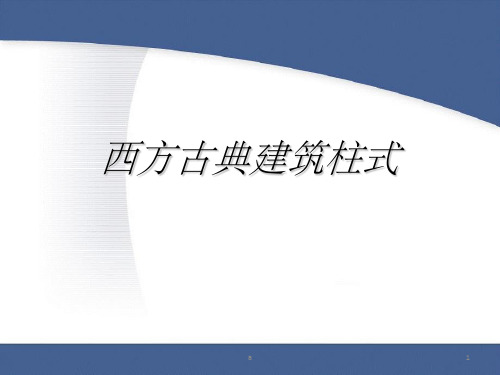
外国建筑史必考——5种古典柱式古典主义代表:5种不同柱式Capitals Of Classical Antiquity: Understand The Difference Between The 5 Orders一般来说,人们对于古典建筑的理解都始于建筑的柱式,无论是其细部分析亦或是建筑表达手法,无一例外。
就历史记载来说,维特鲁威(Vitruvius)在《建筑十书》之中首次对柱式进行了分析:“[...]柱式是一种建筑表达方式,其特点不仅有粗狂干净,也有精致细腻,在真正古典设计之中,柱式的选择是至关重要的问题,这影响了建筑的整体风格。
”[1]因此作者也称之为“建筑语汇”。
[2]建筑的古典语言《The Classical Language of Architecture》的作者约翰·萨莫森(John Summerson)曾经描述道:“[...]一座古典建筑往往选择统一风格的装饰元素,这直接或间接地来源于古典世界的建筑表达[...]。
这些元素易于识别,例如标准化的五种经典柱式,其精准的柱头、柱础,亦或是其他运用于古典建筑的标准化系列的装饰。
”[3]广义来说,经典柱式分为如下五种,即希腊柱式中的多立克、爱奥尼、柯林斯,还有罗马柱式中的塔司干和混合柱式。
不同命名方式来源于柱头等部位的区别,例如柱头或是柱础的装饰区别,亦或是柱身的纹理和比例。
除此之外,经典柱式还有许多组成元素,例如檐口、收分、卷杀、线脚、基座、雕刻等等。
以下是对于5种柱式的简要分析:Whether it's to start analyzing a detail or impressing someone in conversation, understanding a classical building begins with an awareness of the different classical orders of architecture. In the historical records of architecture, the first account of the orders was written by Vitruvius: '[...] The orders came to provide a range of architectural expressions, ranging from roughness and firmness to slenderness and delicacy. In true classical design, order choice is a vital issue—it is the choice of tone,' [1] which for the author, synthesizes the 'architecture grammar.' [2]According to John Summerson, author of The Classical Language of Architecture, '[...] a classic building is one whose decorative elements derive directly or indirectly from the architectural vocabulary of the ancient world—the 'classical' world [...]. These elements are easily recognizable, such as, for example, the five standard types of columns that are used in a standardized way, the standard treatments of openings and pediments, or, still, the standardized series of ornaments that are employed in classical buildings.' [3]Broadly speaking, there are five classic architectural orders: Doric, Ionic, and Corinthian, of Greek character, and the orders Tuscan and Composite, of Roman character. The differentiation of each nomenclature is shown in the composition and/or capital ornamentation—the upper end of the column, responsible for transferring the efforts of the entablature to the shaft and unloading them on the basis. Alongside the capital, there are other constituent elements of the classical orders—cornice, frieze, pediment, architrave, shaft, podium, and pedestal.Here is a brief reference to the differences in the capitals ofthe five classic architectural orders:多立克多立克是最古老且简约的希腊古典柱式,大约出现在公元前七世纪,这种柱式以男性身体为原型,表达简单强壮的寓意,其线条简洁干净,主要在希腊建筑中用于表达男性特征。